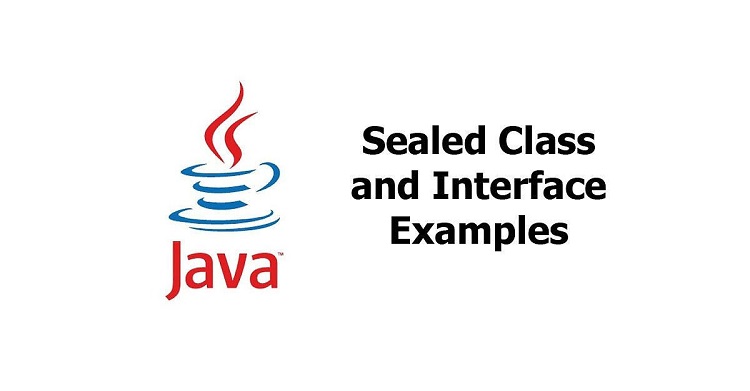Given the following code
sealed interface Super permits Sub1, Sub2, Sub3 {}
non-sealed class Sub1 implements Super {}
record Sub2(Super s) implements Super {}
enum Sub3 implements Super { SUB_A{}, SUB_B{} }
Which statement is true? Choose one.
A. The code compiles as it is.
B. The record Sub2 is invalid.
C. The enum Sub3 is invalid.
D. Both record Sub2 and enum Sub3 are invalid.
Answer. The purpose of sealed types is to let you limit the set of types that can be assignment-compatible with a particular base type.
A common example of inheritance would be a base type Animal with child classes for Lion, Tiger, Bear, and so on. This structure makes perfect sense if you decide to add Snake, Dog, Bird, and any number of additional types that are subtypes of Animal.
Sometimes, however, you might need to model a situation where there are a limited number of possible or permissible subtypes. An example would be a base type Quadrilateral (four-sided geometric shape). The possible subtypes of this would be Square, Rectangle, Parallelogram, Trapezium, Trapezoid, Rhombus, and Kite. (Let’s not get picky about the geometric definitions, as we recall that two of those have different meanings on opposite sides of the Atlantic Ocean!)
There are good reasons (some of which are related to the form of switch/case construction that’s a preview feature in Java 17 and Java 18) why it can be helpful to the integrity of the design to be able to enforce this restriction and not allow any additional subtypes. It’s beyond this article’s scope to discuss those reasons, but it’s sufficient to know that the sealed class syntax is provided to allow you to enforce this.
To make the sealed class syntax work, the syntax must allow you to define a base type (which can be an interface, abstract class, or concrete class) and enumerate the permitted subtypes. Further, the syntax must enforce controls on the subtypes of those subtypes. This goal suggests the following rules:
◉ A sealed type must (generally—but this article will not get into the exception) explicitly declare the permitted subtypes.
◉ Each permitted subtype must either be sealed or final (in which case it cannot have any subtypes).
◉ It’s also permitted to have a subtype that’s explicitly declared as non-sealed, in which case it allows any number of subtypes.
All sealed classes have some interactions with existing type rules. For example, abstract classes and interfaces cannot be final, so that possibility is removed and either of them can be sealed or non-sealed, but they cannot be final.
You can probably guess that enums, which prohibit arbitrary subclassing, and record types, which are implicitly final, also interact with these rules. That will be explored shortly.
Now that you’ve got a good starting point, consider the elements presented in this question.
The declaration of Super is valid. An interface can be sealed, the syntax is good, and the declaration enumerates the three permitted subtypes: Sub1, Sub2, and Sub3.
The declaration of the class Sub1 is also valid. It demonstrates the use of the non-sealed idea. It’s permitted to have arbitrary subtypes, and it’s explicit about that. Thus it is correct.
The record Sub2 declaration is also valid. It’s not labeled final, sealed, or non-sealed, but a record is implicitly final, so it’s acceptable in that respect. Also, although a record cannot declare a parent class, it’s fine for a record to implement an interface, as this one does. You could add the final modifier explicitly, but that is not required, so the code for Sub2 compiles.
The Sub3 enum is interesting. Unlike the record Sub1, an enum is not necessarily final. It’s true that you can’t use extends from an enum, but you can create subclasses if you do so inside the enum itself—and the code in the question does just that.
Both the constant values SUB_A and SUB_B are followed with curly brace pairs, and this means that each instance is a subclass of the Sub3 enum. Because the subtypes of an enum are so tightly controlled, the Java Language Specification treats an enum that contains children in this way as being implicitly sealed. Section 8.9 of the specification for Java 17 says
An enum class is either implicitly final or implicitly sealed, as follows:
◉ An enum class is implicitly final if its declaration contains no enum constants that have a class body.
◉ An enum class E is implicitly sealed if its declaration contains at least one enum constant that has a class body. The permitted direct subclasses of E are the anonymous classes implicitly declared by the enum constants that have a class body.
In the situation where no class bodies were provided for any of the individual enum constants, the enum class would be implicitly final and would work too.
Because the Sub1 class is explicitly marked non-sealed, the record Sub2 is implicitly final, and the enum Sub3 is implicitly sealed, all three are valid and the syntax of the code presented is entirely correct and compiles. In view of that, you can see that option A is correct, and therefore options B, C, and D must be incorrect.
Conclusion. The correct answer is option A.
Source: oracle.com




0 comments:
Post a Comment